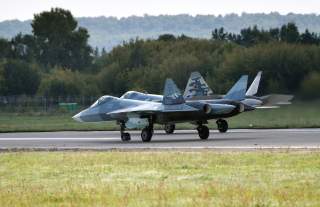Russian Su-57 Stealth Fighters in Africa?
Algeria was rumored to be the first export customer.
Key Point: Rumors or reality?
Rumors circulated in late December 2019 that Algeria had inked a contract with Russia to become the first export customer of the Su-57 stealth fighter.
Be skeptical. The Su-57 hasn’t completed flight testing and lacks key systems. Production of the radar-evading, twin-engine fighter has proved difficult to scale. Sukhoi likely will struggle to fill, on time, Russia’s own orders for the type. Never mind building Su-57s for Algeria, too.
Mena Defense with a Dec. 27, 2019 story helped to legitimize the rumors. “It is now almost official, Algeria has inked a contract for the acquisition of 14 Su-57 stealth fighters and becomes the first customer to whom the manufacturer Sukhoi will export this more advanced Russian fighter,” the story stated.
The Algerian air force has also signed two other contracts for 14 Su-34 bombers and 14 Su-35 air domination aircraft. An option for two other squadrons of 14 aircraft for each type of aircraft was also signed to compensate for the natural withdrawal of aircraft from the air force fleet in the near future.
The contract should be completed by 2025, by this deadline the Algerian army will deploy two wings of Su-30MKA, one squadron of Su-57, one of Su-35 and one of MiG-29M2 for air domination, two squadrons of upgraded Su-24 and one of Su-34 for the bomber fleet. The transformation of the pilots will be done on board the Yak-130.
Notably, no Russian source has confirmed the purported contract signing. That alone is reason to be wary of the Algerian Su-57 claim. Tom Cooper, an author and expert on Russian warplanes, explained to The Aviation Geek Club several other reasons to be skeptical.
For starters, Maj. Gen. Gad Salah, Algeria’s longtime de facto ruler, died on Dec. 23, 2019. Salah was perhaps the biggest advocate of Algeria acquiring the latest Russian weaponry. His death, and the political power struggle that likely is to result, makes any major acquisition less likely.
Also, as Cooper pointed out, Algerian law requires that any new aircraft the military imports be flight-tested in Algeria. “The Russians would never let their customers from abroad do something like weapons-testing in Russia,” Cooper explained. “This is something they [the Russians] must always do at home.”
As Russia likely never would release the Su-57 for testing in Algeria, the Algerian air force would have to break the law in order to acquire the type.
More broadly, the Su-57 simply isn’t ready for export. The Russian air force possesses just a dozen or so of the type, which flew for the first time in 2010 but has suffered from a dearth of funding and the collapse of a co-development deal with India. One of the prototype Su-57s crashed in late December 2019.
As of early 2018, the Su-57 possessed “inadequate and incomplete sensors, incomplete fire-control systems and self-protection suites, no operational integrated avionics and ... unreliable engines,” Cooper noted. The type has conducted hardly any weapons-separation testing and lack any other operational weapons beside its 30-millimeter internal cannon.
The Russian air force in 2019 deployed Su-57 stealth fighters to Syria a second time since first deploying them to the war-torn country in February 2018. But the foreign forays apparently were for show. The stealth fighters apparently didn’t even employ any live weapons during their brief stopovers in Syria.
In deploying Su-57s, the Kremlin was “outright gambling with precious prototypes and their pilots’ lives,” according to Cooper. The aircraft were “flown by pilots who lack any kind of doctrine or tactics for the type and who cannot really depend upon the planes’ avionics and other systems,” according to Cooper.
Shortly following the 2018 deployment, the Kremlin suspended production of the Su-57 after the 28th copy, effectively canceling the program. Russian president Vladimir Putin dramatically revived the program in mid-2019, announcing a plan to buy an additional 48 copies.
The Kremlin ordered its first dozen production-standard Su-57s in August 2018, hoping to form the first regular squadron some time in 2019. With just a few days remaining in 2019, it appears unlikely the squadron will form on time. The delivery schedule includes just two new Su-57s in 2019 and an additional two in 2020.
Turkey has expressed interest in buying the type after Ankara’s insistence on acquiring Russian-made air-defense systems got it kicked out of the American-led F-35 program. Moscow has touted the United Arab Emirates as another potential buyer. These possible sales obviously incentivize Russia to portray the Su-57 as an operational warplane. Algeria is just the latest country to play a role in the Su-57’s mostly fictional drama.
But for all the drama of its de facto cancelation then restart and for all the talk of exports, the Su-57 program remains under-funded and under-developed. It’s one thing for Russia to announce an order for 48 more of the fighters. It’s another for the government actually to pay for the planes, and for Sukhoi actually to build them. Exports in the near term, to Algeria or any other country, are even less likely.
David Axe serves as Defense Editor of the National Interest. He is the author of the graphic novels War Fix, War Is Boring and Machete Squad.
This article first appeared in December 2019. It is being republished due to reader interest.
Image: Reuters.

